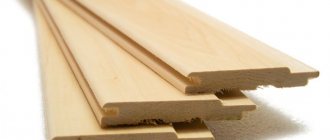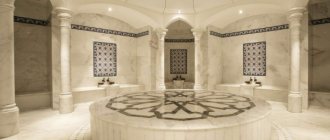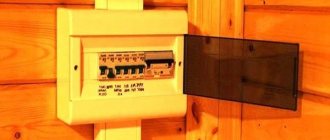Onsens are the natural hot springs on which Japanese baths are based. Thanks to Japan's unique location at the intersection of tectonic plates, there are more than 2,500 natural hot springs throughout the country. Water comes to the surface naturally or is accessible through wells. In Japan, baths are usually taken in three different places: in one's own home, in public baths, and in hot springs.
Hot spring baths
The Japanese love onsen, considering them a gift from the gods, purifying the body and mind, and also reconciling two of the most powerful elements:
fire and water. They serve to relax the soul and detoxify the body. Swimming together in water with a temperature of more than +40°C promotes contemplation and conversation, even with strangers. Foreigners are often shocked that strangers who are naked in a common space are not shy and do not look at others. Yes, in Japan, nudity is the most natural thing in the world. The Japanese openly talk about the benefits of "naked communication" (裸の付き合い). Often in furo internal conflicts are resolved, disputes are settled and common interests are revealed.
The most magnificent onsens are found in the provinces. They are surrounded by the picturesque scenery of the Japanese countryside, many are located next to rivers or have views of the forest, mountains, or sea. Outdoor springs are most impressive, especially in winter, when everything around the hot tub is covered with fluffy snow. City baths, in turn, allow you to truly experience the community of bathing.
History of sento
Modern public Japanese baths in the form in which they can be seen in Japan appeared relatively recently, at the turn of the 19th and 20th centuries. In total, in the history of the development of the country's bath business, three most important periods can be distinguished, when the approach to the arrangement and organization of the work of the sento bathhouse changed radically. Japanese baths not only developed, the technology and principle of bath procedures changed:
- In ancient sento, until the end of the reign of Emperor Meiji, the Japanese bathhouse was built of wood, with the internal lining made of waterproof cedar and larch. Inside there was a steam room and a pool for water treatments, but more often for washing before and after entering the steam room. Early buildings and medieval sento had a very hot steam atmosphere, similar to that practiced in a Russian bath;
- In the 20th century, Japanese sento became predominantly water-based. To warm up and improve health, pools with very hot and cold water began to be built inside the bathhouse. Bath procedures were mainly reduced to long and deep warming of the body and the use of contrast bathing;
- In the middle of the last century, sento began to use modern insulating and finishing materials, stoves, boilers and pipelines. The comfort level of the Japanese bath has increased several times.
Surprisingly, it was in Japan, which is distinguished by its commitment to preserving traditions, that changes to the structure of sento were introduced by force, by decrees of local princes and feudal lords. Firstly, it was necessary to heal the population as effectively as possible, to save them from disease and pestilence. Secondly, steam heating required a large amount of firewood and high-quality stoves. Often Japanese peasants and merchants simply died from carbon monoxide when visiting sento.
Modern bathhouse decorated in traditional Japanese style
For your information! In Japanese public baths of medieval construction, the ceiling height in the steam room did not exceed 80-100 cm, there were no windows, it was dark and incredibly hot. You literally had to enter on all fours.
It is clear that the traditional old sento in Japan are public baths. Both women and men steamed and washed in them at the same time. Division existed only along class and caste lines. It was only in the twentieth century that the mixed principle was abandoned in Japanese baths, and divisions and restrictions on visiting sento together were clearly introduced.
Home baths
Furo is an important part of the Japanese lifestyle, who return home after a long day at work looking forward to relaxing and warming up in wooden bathtubs. This is the most common form of bathing in Japan, perhaps because it is the easiest method as more citizens can afford to have a bath at home.
Japanese families are bathed in hierarchy. The eldest and the man go first. In a typical family, the order would be something like this: grandfather first, then father, son, grandmother, mother, and finally daughter.
In their own homes, the Japanese have separate bathing areas, separate from the toilet. In these rooms, the entire floor is waterproof, most often made of tiles or tiles.
The bathing area has a shower hose with mixer tap or a bucket of water for rinsing. There is usually a stool on the floor next to the bathtub that you can sit on to soap your hair and body. And then, only after rinsing, the bather can enter the bath. A very important part of the ritual is thorough washing before immersion in the water, since all other family members will bathe in it and it must be kept clean.
Bathtubs in Japanese homes have a lid to keep the water warm until the next family member starts bathing. This container remains completely filled until the owner of the house deems it necessary to drain the water.
The Japanese bath is shorter and deeper than its European equivalent. Sitting in it, you can rarely straighten your legs, but the bather is immersed in the water to the tip of his chin. Some of them are equipped with electronics and independently control the temperature. In most homes, the furo is now a standard room, but the cult of communal bathing lives on. The Japanese willingly and often use onsen and like to go to ryokans with their own beaches for swimming on weekends. This is an integral element of Japanese culture.
Modern furos can be made from acrylic, and top-end options often feature a recirculation unit (oidaki) that filters and reheats the water. This system is connected to a gas-fired water heater or an electric/heat pump. Luxury models are still made from traditional or expensive woods such as hinoki. They can be complemented with Western-style fittings.
What does it represent?
As already mentioned, Japanese bathhouse traditions cannot be called a bath in the usual sense of the word. There are no large steam rooms, dressing rooms, and the usual bath attributes are not used. In fact, the visitor finds himself in a small room with a large wooden barrel and a free-standing couch.
All bath procedures consist of taking a bath in this container. However, due to some features, this method of ablution brings much greater benefits than, for example, a conventional aromatic bath.
In Japanese culture, it is customary to divide baths into:
Sento
Furaco
Ofuro
Only sento is considered public. This wash room can accommodate several dozen visitors. Meanwhile, furaco and ofuro are always small rooms intended for a maximum of one or two visitors.
Such baths are very popular as an option for home use. They are quite simple to equip, and they are not demanding on space.
The main feature of Japanese baths is that, unlike European and Eastern options, the air here does not warm up so much, and the humidity also remains at the usual level. The entire effect is achieved by immersion in very hot water and a vat of heated sawdust or pebbles.
Such features were formed under the influence of several factors:
- Buddhism was seriously widespread in Japan. Since at the time of the first baths soap was made from the fat of killed animals, true Buddhists were prohibited from using it according to the laws of Ahimsa. However, it was quite difficult to wash well without soap, as a result of which the water was heated up more than usual for a better effect. For a person who has never visited a Japanese bath, such a temperature will be unusual, and in some cases even unbearable.
- In general, there are quite a lot of thermal springs in Japan, and they were used to warm up. However, it was not always easy to get to them, so such home saunas began to be used as a convenient replacement.
- According to religious views, it was forbidden to wear things made of natural fur. While simple cotton fabrics did not warm well in cold weather.
- Japanese houses were not distinguished by thick walls; it was cool inside, especially in winter. Such hot baths helped to warm up.
Sento
Sento still hasn't lost its popularity. These are quite spacious rooms, divided into two parts - men's and women's.
Instead of a barrel of water, a large pool with hot water (up to 60°C) is installed in the room. Several visitors can be in it at the same time.
A visit to the bathhouse takes place in the following order:
- First you need to wash yourself well. There is a special room with a shower for this purpose. Benches are located under the shower for convenience, so you can take it while sitting. Contrasting water procedures are also recommended.
- Then you can move to the room with the pool. However, since the water is very hot, you can stay in it for no more than 15 minutes.
- After the pool you definitely need to relax. For this purpose, public baths have special rooms with benches and other amenities. In some cases, visitors are even provided with access to real Japanese gardens.
- It is recommended to end your visit to the bathhouse with tea.
On a note! If a visitor is lucky enough to visit a real Japanese sento, you should know that the Japanese have a wary attitude towards clients with tattoos. A small tattoo can be covered with a towel, but if the tattoo is large, the visitor may simply not be allowed into some public baths.
Furaco
Refers to a special type of Japanese baths. This is a small room with a barrel-shaped font. It is usually separated by a partition. In the smaller part there is a furnace for heating water; as a rule, it is made of stainless steel.
Visitors with experience are advised not to give up furaco right away. Of course, it is unusual to withstand such a high temperature for the first time. However, after several regular visits, the body gradually adapts.
The procedure itself, as in sento, begins with taking a shower. In this case, you can also resort to contrasting water procedures. In addition, you can first warm up well under the hot streams, after which you can also additionally steam your feet in a separate wooden basin.
At this stage, some Japanese establishments additionally offer foot massage with impact on acupuncture points.
The process then goes like this:
- It is necessary to immerse yourself in hot water, but only in such a way that the water level is below the heart. Under no circumstances should you immerse your entire chest in such hot water. The heart rate already increases to 100-120 beats per minute and blood pressure noticeably increases.
- You need to stay in furaco for no more than 15 minutes. For the first time, you should limit yourself to ten.
- After taking a bath, you should lie down on the couch and relax. According to tradition, this stage should last at least an hour. During this time, the whole body will warm up perfectly, and your thoughts and nerves will come into order.
On a note! To enhance the effect, you can add salts, aromatic oils, flower and herbal extracts to the water.
Ofuro
This is another unusual bathtub. However, it is not filled with water, but with sawdust or stones. A wooden container of full human height with strong walls is equipped with heating elements; in modern realities, it is additionally equipped with remote control and various modes.
It is usually filled with cedar or linden sawdust.
At the same time, they are mixed with herbs or beneficial roots (composed of more than 60 items).
The container contains about 45-50 kg of this mixture. After each visit, the top layer (about 2 kg) is removed and replaced with a fresh one.
This unusual bath mixture is then moistened and heated to 50-60°C.
When the bath is filled, the visitor can only plunge into the sawdust up to his neck. It is recommended to remain in this state for about 20-30 minutes.
Expert opinion
Yaremchuk Svetlana Sergeevna
The owner of a SPA salon knows everything about beauty treatments
This “bath” warms up the body perfectly. In this case, the sweat is immediately absorbed by the sawdust. This gives an excellent effect for the skin - color and condition improve, inflammation and rashes decrease.
When the sawdust stage is completed, another bath awaits the visitor, but in a box filled with heated dry pebbles. Place a dry sheet or towel on top of the stones. The visitor lies on such an improvised bed with his back and lies quietly for 10 to 15 minutes. You can also sit on your stomach; in this case, larger heated stones are additionally placed along the spine.
Interesting to know ! Some exotic places even offer similar baths filled with volcanic ash.
Circular economy
The water temperature in furo is usually around +40°C. The hot liquid helps the body relax and warm up, so the Japanese usually take a bath before bed as they believe it helps them fall asleep and also relieves stress.
Modern home furos have temperature control, which helps save water because it can be kept warm. Depending on use, a full bath can be reused for several days. In large families where parents and children take daily baths, the wooden container is usually filled once or twice a week.
The Japanese really don't like wasting water and practice a reuse system at home. After the water is no longer useful for baths, they connect a washing machine to the tank and use its contents to wash clothes. Thus, saving water and relaxing the body have some kind of relationship.
Ofuro in detail
The modern Ofuro bathhouse is a rectangular box made of natural wood. This structure is filled with mineral water from thermal springs or hot sawdust. In some cases, sea stones or cedar cones are added to the barrel.
The barrel is an integral attribute of relaxation procedures in Japan. The average temperature inside is about 30-60°C, which is quite enough for a feeling of comfort, relaxation and absolute relaxation. In Japan, steam rooms of this kind are installed in private houses and even apartments, and in Russia they can be found in spas, bath centers, health centers, cosmetology clinics, etc.
The ofuro bath is considered the best treat in the Japanese home and a proven medicine for treating ailments.
Classic barrel size: 200x80x80 cm. Modern ofuros are connected to an electrical power source, thanks to which you can regulate the heating temperature of the “insides” (be it sawdust, water or stones). Inside each barrel there is a thermal insulation composition. To achieve the best effect, sawdust can be mixed with essential oils, herbs, minerals, as well as crushed wood and pine cones. Thus, inside the steam room contains a real elixir of useful and well-chosen ingredients!
Traditions of public Japanese baths
Gaijin, which is part of the general furo, always causes slight concern among local residents. There is a fear that a foreigner will not know how to behave. Therefore, it is worth getting acquainted with etiquette.
People with extensive tattoos are not allowed into the furo. Smaller tattoos can be covered with a waterproof plaster, but this is not an ideal solution as it draws attention to what is hidden underneath. In addition, under the influence of water and steam, it may well fall off. Tattoos are not objected to in most hotel baths and private conservation areas (kashikiri) - frankly, this is the best option for those with tattoos. Under no circumstances should photographs be taken after entering the locker room (unless it is a private room in a private onsen)
Further evolution: open space
Sento were originally designed so that steam would not escape from the bathroom; they were entered through a low door, had virtually no windows, and were dark.
Such sento existed until the end of the Edo period, and the Meiji government, hearing criticism of Japanese baths from foreigners, banned communal baths and ordered baths to be located in open spaces. In Meiji 10 (1877), a sento appeared in the Kanda quarter of Tokyo, where in the open space there was a bath pool combined with a changing room with a high ceiling and a steam hood. Such sento were called “improved baths” (kairyo furo).
This is how the basic structure of sento as we know it today was formed. Then they began to use tiles, taps appeared, and in Meiji 41 (1908) in Tokyo the number of sento increased to 1217.
Nationwide, their number was highest in 1968 at 18,325, according to the Sento Association.
Locker room
As almost everywhere else in Japan, you must remove your shoes before entering the onsen (and usually before entering the changing area). After this, visitors need to find a suitable changing room. Most onsen are divided into men's and women's areas, so it is important to recognize the moment when it is time for opposite-sex couples to go their separate ways. On women's doors there should be a sign 女, and on men's doors there should be a sign with the hieroglyph 男, but the differences can also be seen by color - women's doors are red or pink, and men's doors are painted blue. When in doubt, it's best to watch the locals. Some onsen allow you to rent private space for a small group or couple. Then gender issues cease to be important, because in this case visitors will be provided with a separate closed area: a changing room and a swimming area.
It is worth emphasizing once again that onsen are visited completely naked, in the company of complete strangers naked people of the same sex. This is not about sexual nudity as it is understood in other countries. In this case, depriving people of clothes has a symbolic meaning; it puts them on the same level. They are equal, there is no division between them by profession or social class.
If a foreigner is intimidated by a shared bath, he can always rent a private onsen. Outdoor communal hot baths should be sought in the provinces. They are called konyoku-buro.
The locker room has individual baskets for clothes and personal items or lockers. All clothes, watches, phones, bags and cosmetic bags should be left here. Even if all this is in open baskets, there is no need to fear that any item will be lost or stolen.
Features of sento
A visit to a Japanese bath is also one of the traditional ceremonies of Japan. Therefore, people often go to the bathhouse not only to wash themselves and relieve physical stress, but also to relax psychologically. Another unusual function of sento is emotional release and relaxation, in conversations with trained, specially trained personnel posing as visitors. The majority of Japanese people are introverts and individualists by nature, so a visit to a Japanese bathhouse often successfully replaces a visit to a psychologist.
Benefits and harms
Communication and relaxation in the company of polite and courteous professional interlocutors is a huge advantage of a Japanese bath, even if sento is inferior to modern bath complexes in the variety of procedures and types of spa. The Japanese often bring children in order to make them more open and prepared to communicate with adult society.
The second big plus is the presence of a professionally designed hardening system. A visit to sento is recommended for everyone who is involved in very heavy physical activity; hot mineral water relieves pain from muscles and ligaments.
On the other hand, the Japanese bath has always been narrowly focused. It is planned and focused specifically on the preferences and traditions of the average resident of the country. Typically, a European views a visit to a Japanese bath as an excellent restorative, but after just a dozen visits, the measured and calm atmosphere of a sento turns into a routine. As experts say, you need to be a fan of Japanese culture in order to correctly perceive going to the bathhouse and enjoy it.
After the bath there is the opportunity to relax in the fresh air in the garden
Contraindications for visiting
It is impossible to treat asthma or vascular diseases there, so the staff always warns before visiting about the presence of contraindications:
- Diseases of the heart and blood vessels;
- Presence of musculoskeletal injuries;
- Infectious and oncological diseases.
The most serious limitation is associated with blood vessels and neuralgia. A contrast shower in a Japanese bath is noticeably harsher than dousing in a Russian bath and sauna. Therefore, you can use this procedure only if you have no health problems. Otherwise, you can develop rheumatism or hypertensive crisis. But at the same time, the healing effect in sento is noticeably higher than that of traditional European, Finnish and Russian baths.
Bathroom
In the transition from the locker room to the onsen there are sometimes washbasins with mirrors, next to which you can wash your face or fix your hair. This is the ideal place and time to secure long hair with an elastic band or pin, the visitor should not soak it in the general bathing area.
The best place to wash your body is in the shower. A row of shower stalls or taps is located along the wall. Under them you can always find stools, bowls or buckets. Each person takes a chair and washes well. Visitors carefully wash every part of the body and hair, douse themselves with water, and sometimes repeat the procedure from scratch several times. At the same time, every local resident saves water, so they collect it in a bucket whenever possible. This is a public place where everyone wants to be in spotless water, so the body needs to be thoroughly washed and rinsed.
Cosmetics and towels
Most private onsen have all the necessary cosmetics, and these are good brands (Shiseido or Kanebo), that is, you don’t need to take creams and shampoos with you. The same goes for towels. Usually each visitor receives two pieces: a large one and a small one. The bathhouses cover your hot body in the locker room, which is very convenient after leaving the furo. A small towel is used to go to the changing room after a hot bath. The towel should not be soaked in furo or twisted. It should be folded into a square or rectangle and placed on your head, then go into the water. You must not touch anyone with the towel. It is also unacceptable to spread it on stones or the edge of the furo. Of course, if a bather rents a kashikiri, he can safely put his towel even on the floor, which otherwise will cause a full-fledged scandal.
Women should remember to remove their makeup. Entry into the furo with a painted face is prohibited. However, at this temperature, the paint will quickly flow, and black circles a la “panda” will appear around the eyes.
In public baths, you need your own towel and cosmetics, and you should also take a clean set of clothes with you, as a visit to the onsen is a real refreshment and cleansing of the body.
How is it useful?
In addition to the obvious effect of excellent cleansing, the Japanese bath has other beneficial properties:
On a regular visit:
- Stress and nervous tension are reduced. Long relaxation sessions help fight depression and anxiety.
- Through heated skin, waste and toxins are well removed. Tree resins are disinfected and disinfected.
- Along with sweat, excess fluid comes out, swelling decreases, and weight normalizes. It is believed that the Japanese rarely gain extra pounds, largely due to regular visits to the bathhouse.
- Helps with muscle spasms or after intense exercise. Hot stone baths also have the ability to relieve myalgia.
- Blood circulation improves. This is a good prevention of cardiovascular diseases.
- The condition of the joints improves. It is especially recommended to visit Japanese baths for people with gout, arthrosis, arthritis, etc. Healing sessions relieve pain and increase mobility.
- It has an excellent effect on the skin, accelerates regeneration processes and has a rejuvenating effect. Taking baths with sawdust is a kind of peeling.
- With long-term visits to the bathhouse, the immune system is strengthened, and the visitor is less likely to be exposed to colds and viral diseases.
When visiting a Japanese bath, you should pay attention to contraindications:
- Pregnant women should not practice such procedures.
- Also, children under 3 years of age should not visit the bathhouse.
- If you have cardiovascular diseases, you must first consult a doctor.
- Serious diseases of the respiratory system, for example, tuberculosis, are a reason to refuse to visit a Japanese bath.
- Exacerbation of chronic or colds and viral diseases is not the best time for such procedures.
How to properly conduct sessions
A person plunges into the water and simply sits in the furo, warming up the body. It does not swim, dive, splash, or move around unnecessarily. Any noisy, nervous and fast movements are considered bad manners. The visitor should slowly enter the bathing area and take a comfortable seat. After this, you should just relax, think or talk quietly with your neighbor. You cannot dive headlong; it is best to sit in water up to your neck. It is worth discreetly observing the local residents and their behavior, but at the same time avoid looking directly at naked people.
Development of sentō during the Edo period and the popularity of communal baths
The greatest development of public sento baths as part of people's daily life occurred during the Edo period (1603-1868).
The first written mention of sento in Edo dates back to Tensho 19 (1591), when a man named Ise Yoichi built a “sento bath” near a bridge located where the main building of the Bank of Japan is now located in Tokyo's Chiyoda Ward. Documents from that time say that the place became very popular and the business quickly expanded.
Ten years after Ise Yoichi set up his bathhouse, there were already sentos in every neighborhood.
Documents from 1810 state that there were 523 sento working in Edo, which suggests that the city's residents were very fond of public baths.
During the Edo period, sento evolved, and among them two main types can be distinguished: baths where men and women washed separately, and common ones. There were many communal bathhouses in the western Kansai region, and fewer in Edo, but communal bathhouses were successful. This is partly due to the fact that it was easier and cheaper for the owners to maintain one department rather than two, and in addition, such bathhouses employed yuna bath attendants - women who washed men. Since it was believed that communal bathing and bathing attendants were corrupting public morals, the shogun's government issued decrees prohibiting communal bathing and limiting the number of bathing attendants, but such decrees, popularly called the “three-day ban” (mikka hatto), were not very much implemented.
There are two main types of sento structure at the beginning of the Edo period. The first was called furoya, where there were steam cabins, the second - yuya, where they swam in pools. People preferred the latter, so furoya as such almost disappeared, leaving only the word for sento or its owner.
Well-being
The water in the furo is actually very hot. You need to get used to this slowly. Therefore, even if a person feels inconvenience and discomfort due to lack of clothing, one should enter the water very slowly. If you still experience a feeling of weakness or shortness of breath, you need to move closer to the shore, to a higher step and sit in the water only up to your waist. You can also place a cool compress on your head. Usually this helps and after a few seconds the situation returns to normal. If the visitor still feels unwell or is too hot, they can return to the shower room to cool down a little with a cool shower.
It must be remembered that the bather can always leave the furo, this is not frowned upon and you should not do anything against your wishes and well-being. There is no specific time that a visitor must spend in the furo. You should stay there as long as you like and enjoy it. Large onsen have a relaxation area where you can even take a nap, drink juice or alcohol, eat, enjoy a massage, sauna and other post-swim treatments.











